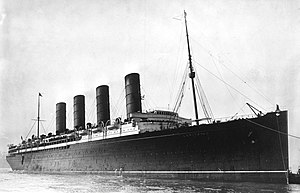RMS Lusitania

Lusitania arriving in port
|
|
| History | |
|---|---|
|
|
|
| Name: | Lusitania |
| Owner: | Cunard Line |
| Operator: | Cunard Line |
| Port of registry: | Liverpool |
| Route: | Liverpool to New York City |
| Builder: | John Brown & Co, Clydebank, Scotland |
| Yard number: | 367 |
| Laid down: | 17 August 1904 |
| Launched: | 7 June 1906 |
| Christened: | Mary, Lady Inverclyde |
| Acquired: | 26 August 1907 |
| Maiden voyage: | 7 September 1907 |
| In service: | 1907–1915 |
| Fate: | Torpedoed by German U-boat U-20 on Friday 7 May 1915. Wreck lies approximately 11 mi (18 km) off the Old Head of Kinsale Lighthouse in 300 ft (91 m) of water at 51°25′N 8°33′W / 51.417°N 8.550°WCoordinates: 51°25′N 8°33′W / 51.417°N 8.550°W |
| Status: | Partially-collapsed wreck |
| General characteristics | |
| Type: | Ocean liner |
| Tonnage: | 31,550 GRT |
| Displacement: | 44,060 long tons (44,767.0 t) |
| Length: | 787 ft (239.9 m) |
| Beam: | 87 ft (26.5 m) |
| Height: | 60 ft (18.3 m) to boat deck, 165 ft (50.3 m) to aerials |
| Draught: | 33.6 ft (10.2 m) |
| Decks: | 9 passenger decks |
| Installed power: | 25 Scotch boilers. Four direct-acting Parsons steam turbines producing 76,000 hp (57 MW). |
| Propulsion: | Four triple blade propellers. (Quadruple blade propellers installed in 1909). |
| Speed: | 25 knots (46 km/h; 29 mph) 28 knots (52 km/h; 32 mph) (top speed, single day's run in March 1914) |
| Capacity: | 552 first class, 460 second class, 1,186 third class. 2,198 total. 7,000 tons coal. |
| Crew: | 850 |
| Notes: | First ship of Cunard's four funneled grand trio, along with RMS Mauretania and RMS Aquitania |
RMS Lusitania was a British ocean liner that a German submarine sank in World War I, causing a major diplomatic uproar. The ship was a holder of the Blue Riband, and briefly the world's largest passenger ship until the completion of her sister ship Mauretania. The Cunard Line launched Lusitania in 1906, at a time of fierce competition for the North Atlantic trade. She made a total of 202 trans-Atlantic crossings.
German shipping lines were aggressive competitors in the transatlantic trade, and Cunard responded by trying to outdo them in speed, capacity, and luxury. Both Lusitania and Mauretania were fitted with revolutionary new turbine engines, that enabled them to maintain a service speed of 25 knots (46 km/h; 29 mph). They were equipped with lifts, wireless telegraph, and electric light, and provided 50% more passenger space than any other ship; the first class decks were noted for their sumptuous furnishings.
When RMS Lusitania left New York for Britain on 1 May 1915, German submarine warfare was intensifying in the Atlantic. Germany had declared the seas around the United Kingdom a war zone, and the German embassy in the United States had placed a newspaper advertisement warning people of the dangers of sailing on Lusitania. On the afternoon of 7 May, a German U-Boat torpedoed Lusitania, 11 mi (18 km) off the southern coast of Ireland and inside the declared war zone. A second, unexplained, internal explosion sent her to the seabed in 18 minutes, with the deaths of 1,198 passengers and crew.
Because the Germans sank, without warning, what was officially a non-military ship, many accused them of breaching the internationally recognized Cruiser Rules. However it was no longer possible for submarines to give warning due to the British introduction of Q-ships in 1915 with concealed deck guns. (Lusitania had been fitted with 6-inch gun mounts in 1913, though she was not armed at the time of her sinking.) The Germans justified their treating Lusitania as a naval vessel because she was carrying hundreds of tons of war munitions, therefore making her a legitimate military target, and pointed out that British merchant ships had violated the Cruiser Rules from the very beginning of the war. The sinking caused a storm of protest in the United States as 128 American citizens were among the dead. The sinking helped shift public opinion in the United States against Germany, and was a factor in the United States' declaration of war nearly two years later.
...
Wikipedia
